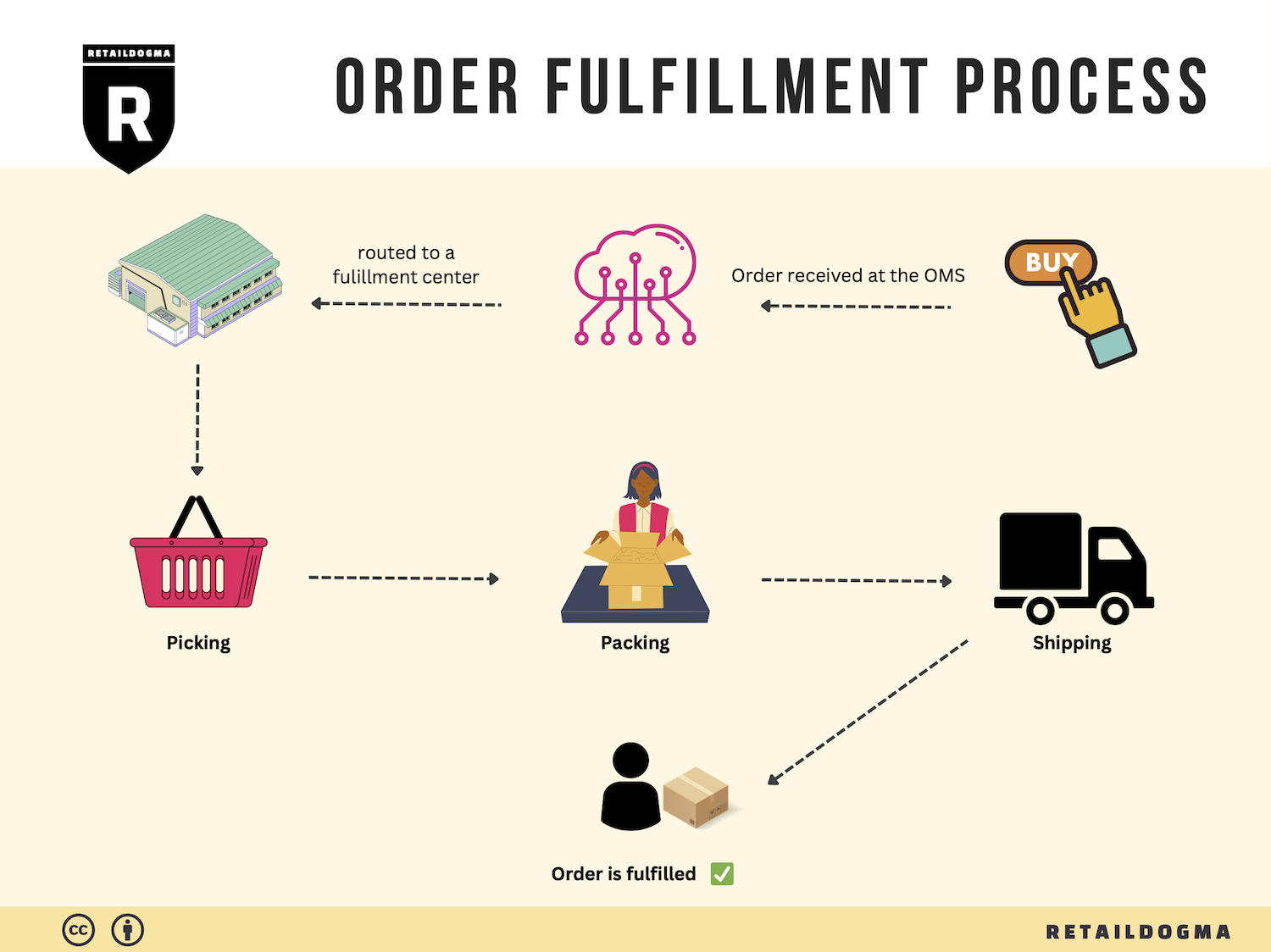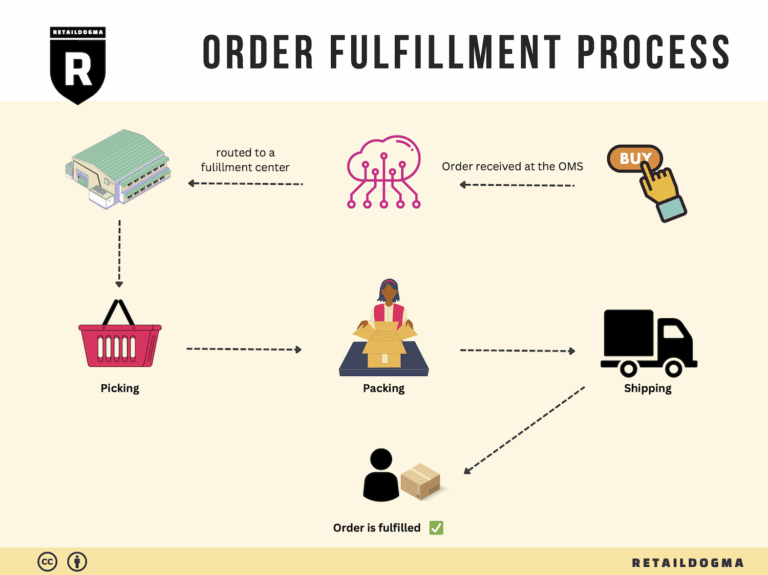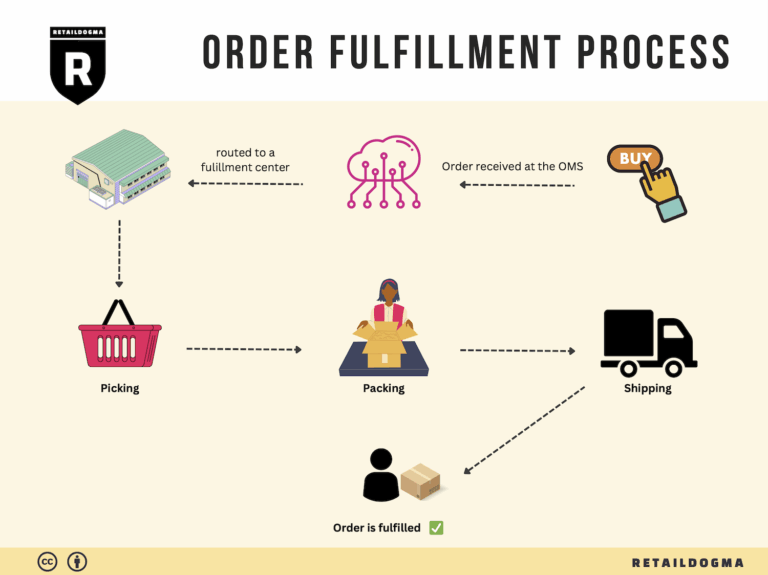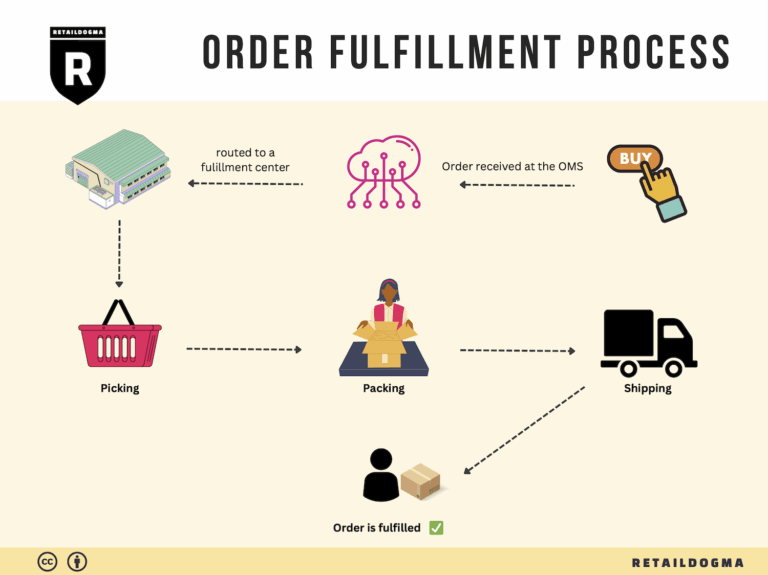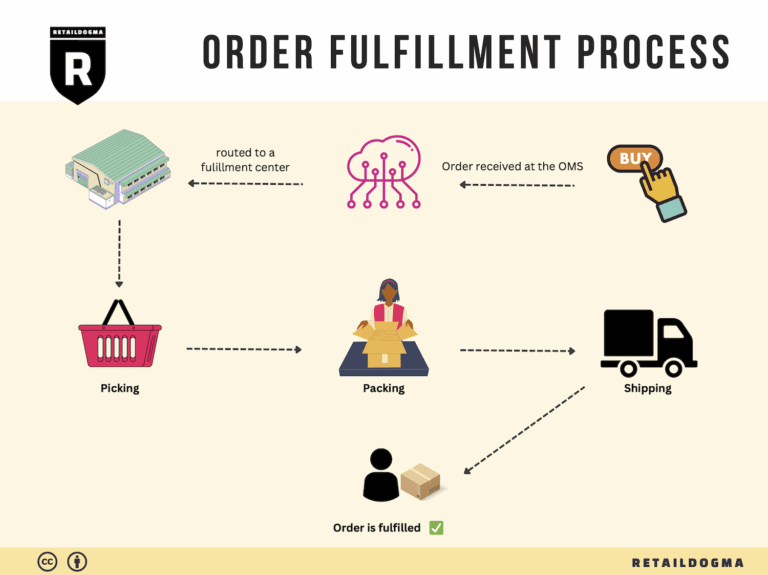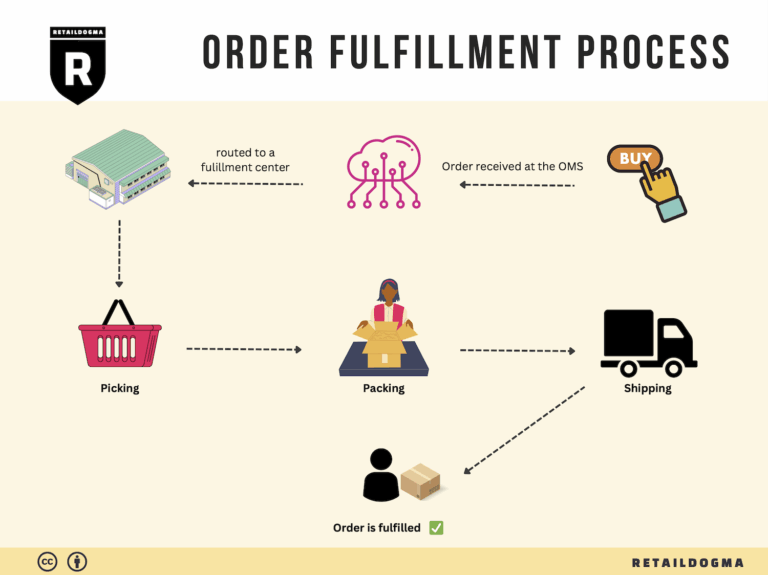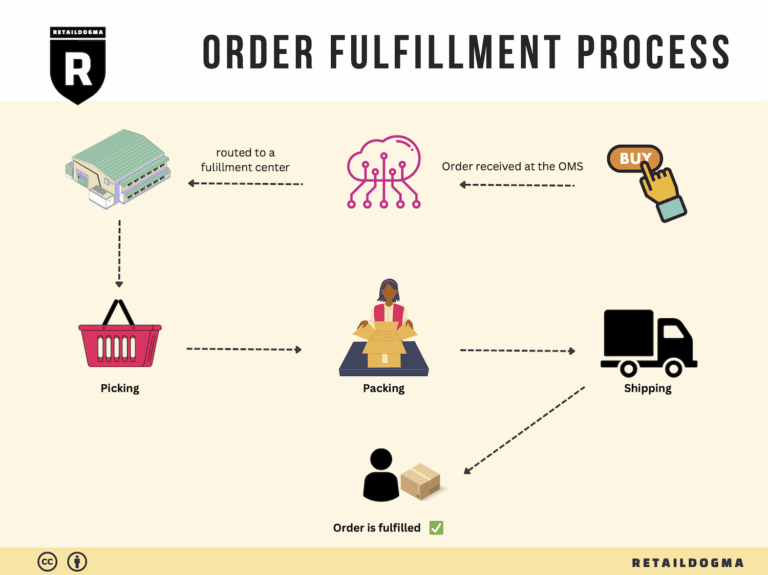How Order Fulfillment Works: A Step-by-Step Guide for Businesses
What is E-commerce Fulfillment? An Introduction for Growing Businesses
Understanding E-commerce Fulfillment
As an e-commerce business owner, you may find yourself grappling with the complexities of packing and shipping orders. This overwhelming process can lead to delays, customer dissatisfaction, and a potential decline in sales. The fulfillment process, which is essentially the journey of getting a product from your inventory to your customer’s doorstep, is a critical component of your operations.
E-commerce fulfillment is not just about packing boxes; it encompasses a series of interconnected steps that include inventory management, order processing, and shipping logistics. As your business scales, the challenge of managing these processes efficiently grows. A well-structured fulfillment strategy can help you navigate these challenges while enhancing customer satisfaction.
This guide aims to demystify the fulfillment process for growing e-commerce businesses. We will explore various fulfillment models, including Third-Party Logistics (3PL) and Fulfillment by Amazon (FBA), to help you understand which option best aligns with your business needs. Each model comes with its own set of advantages and considerations, making it essential to choose wisely.
Furthermore, we will delve into the core services that fulfillment partners typically offer, such as inventory storage, order processing, and shipping management. Knowing what services to expect will empower you to make informed decisions when selecting a fulfillment partner.
Choosing the right logistics partner is another critical aspect we will cover. Factors such as technology integration, shipping options, and customer service quality can significantly impact your fulfillment efficiency. We will provide practical tips on how to evaluate potential partners to ensure they meet your operational needs.
Lastly, pricing is an essential component of your fulfillment strategy. Understanding the costs associated with different fulfillment models will enable you to budget effectively and maintain healthy profit margins. This guide will break down typical pricing structures and highlight key considerations to help you navigate the financial aspect of fulfillment.
Our goal is to empower your business with the knowledge to make smart, informed decisions about your logistics operations. By optimizing your fulfillment process, you can not only improve customer satisfaction but also set the stage for sustainable growth. Let’s dive in and explore the world of e-commerce fulfillment together.
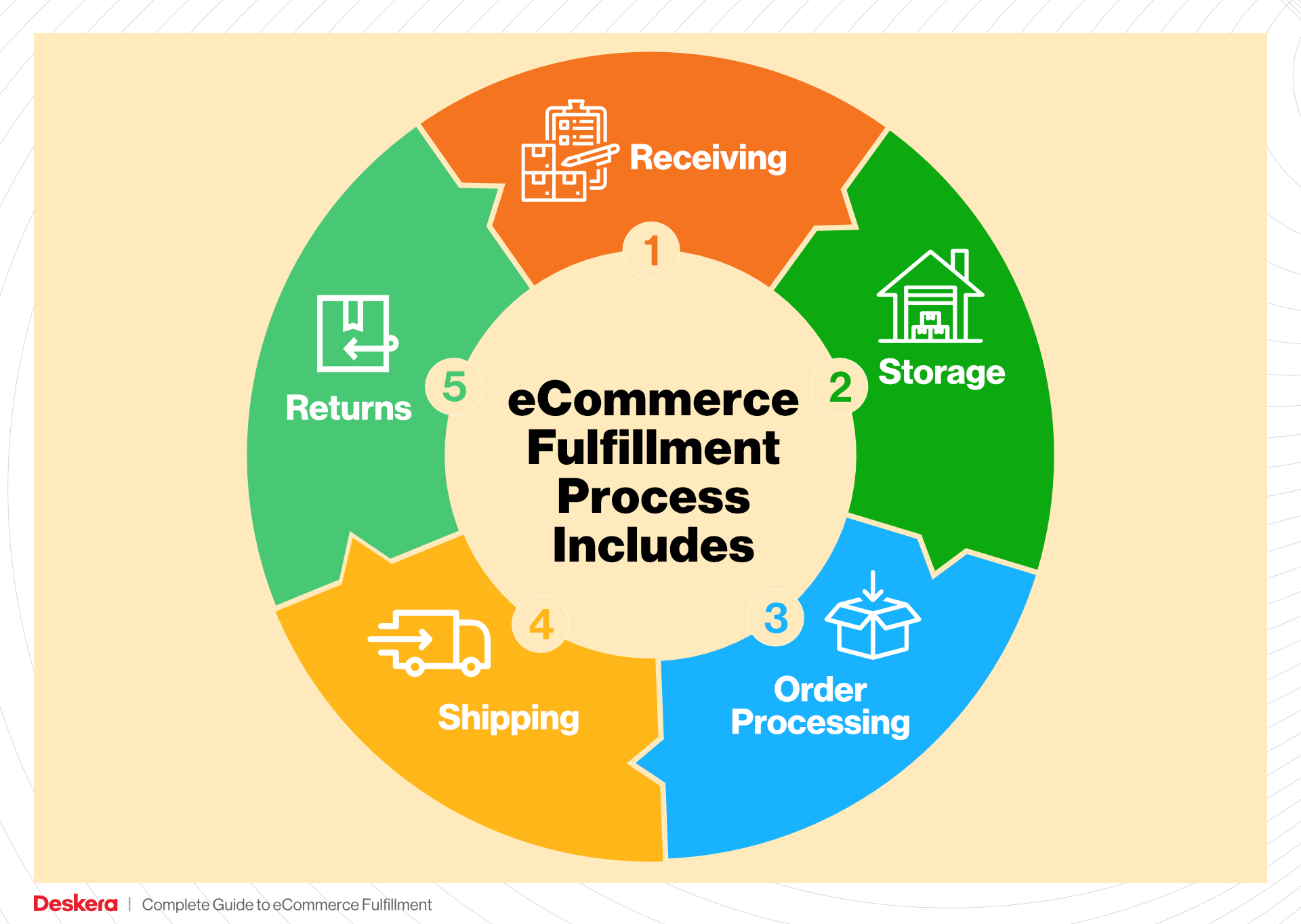
What You’ll Learn In This Guide
- What is E-commerce Fulfillment? An Introduction for Growing Businesses
- The Order Fulfillment Process: From ‘Buy’ Button to Customer’s Door
- Comparing Fulfillment Models: In-House vs. 3PL vs. Dropshipping
- A Deep Dive into Amazon FBA: Pros, Cons, and Who It’s For
- Core Services Offered by Fulfillment Centers
- How to Choose a Fulfillment Partner: A 6-Point Checklist
- Understanding Fulfillment Pricing: A Breakdown of Common Fees
- Frequently Asked Questions (FAQs) about Fulfillment
- Conclusion: Is Outsourcing Fulfillment the Right Move for Your Business?
- Important Disclaimer
The Order Fulfillment Process: From ‘Buy’ Button to Customer’s Door
1. Receiving Inventory
The order fulfillment process begins with receiving inventory. This step involves the arrival of products from suppliers or manufacturers at your warehouse. Each shipment is checked against purchase orders to ensure accuracy, with an emphasis on identifying any discrepancies such as damaged or missing items. This stage is crucial because it sets the foundation for your inventory management system.
Key Term: SKU (Stock Keeping Unit)
Each item should have a unique SKU, which simplifies tracking and management. Accurate receiving ensures that inventory levels are correctly updated in your system, allowing for real-time visibility of stock availability. This is particularly important in e-commerce, where customers expect up-to-date information on product availability. A smooth receiving process minimizes delays later in the order fulfillment chain and enhances overall operational efficiency.
2. Warehouse Storage
Once inventory is received, it is stored in the warehouse. Effective warehouse storage involves organizing products in a way that maximizes space and facilitates efficient picking. This can be achieved through various strategies, such as FIFO (First In, First Out) for perishable goods or ABC analysis, which prioritizes the storage of high-demand items near packing stations.
Key Term: Location Codes
Assigning location codes to different storage areas helps staff quickly locate items. This step is vital for maintaining an organized warehouse, reducing search times, and minimizing errors during the picking process. Proper storage practices not only streamline operations but also contribute to improved inventory accuracy, which is essential for meeting customer expectations.
3. Order Picking
The next step is order picking, where items are retrieved from their storage locations based on customer orders. This process usually begins when an order is placed, triggering the generation of a pick list—a document that details the items to be collected, their quantities, and their locations within the warehouse.
Key Term: Pick Lists
Utilizing pick lists is essential for efficient order fulfillment. They help warehouse staff quickly and accurately gather items, reducing the time spent on each order. Implementing technology such as barcode scanners can further enhance picking accuracy and speed. Efficient order picking directly impacts the customer experience by ensuring that orders are fulfilled correctly and promptly, thus reducing the waiting time for customers.
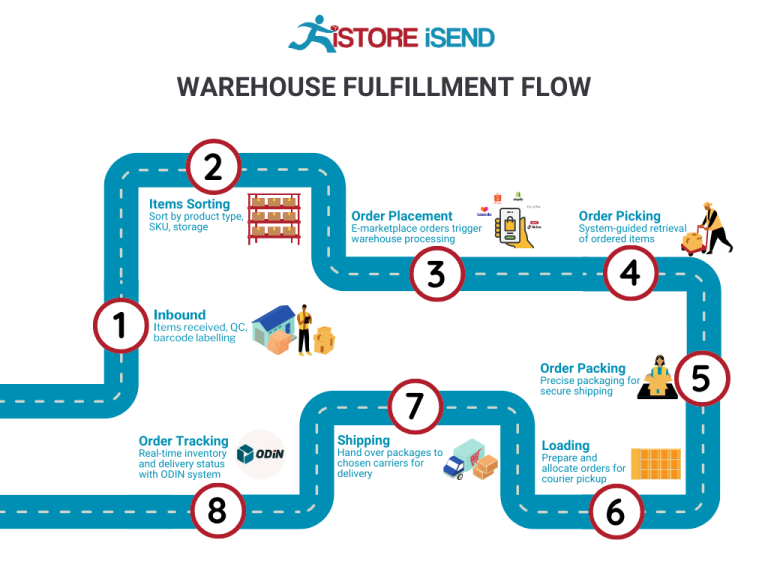
4. Order Packing
After the items have been picked, they move to the packing station, where they are prepared for shipment. This stage involves checking the items against the order details to ensure accuracy, then securely packing them to prevent damage during transit. Packaging materials should be chosen carefully based on the nature of the products being shipped.
Key Term: Packing Slips
A packing slip, which includes information about the items in the package, is often included with the shipment. Proper packing not only protects the products but also enhances the customer experience. An appealing and secure package can lead to positive impressions, encouraging repeat business. Moreover, efficient packing procedures help streamline the shipping process, ensuring that orders are dispatched quickly.
5. Shipping & Delivery
The final step in the order fulfillment process is shipping and delivery. Once the package is packed, it is labeled and handed over to a shipping carrier. This step includes selecting the appropriate shipping method based on factors such as cost, speed, and customer preferences.
Key Term: Shipping Labels
Shipping labels contain essential information for the carrier, including the destination address, tracking number, and return address. Accurate labeling is critical for preventing lost packages and ensuring timely delivery. Once shipped, customers should receive tracking information, allowing them to monitor their order’s progress. Efficient shipping practices are vital, as they significantly influence customer satisfaction and retention.
By understanding and optimizing each of these five steps—receiving inventory, warehouse storage, order picking, order packing, and shipping & delivery—e-commerce businesses can streamline their order fulfillment processes. This not only improves operational efficiency but also enhances the customer experience, ultimately driving sales and fostering brand loyalty.

Comparing Fulfillment Models: In-House vs. 3PL vs. Dropshipping
Fulfillment Model Comparison
| Model | Who Handles Inventory | Best For (Business Stage) | Key Advantage | Key Disadvantage |
|---|---|---|---|---|
| In-House Fulfillment | The business itself | Established businesses | Full control over inventory and quality | High overhead costs and labor-intensive |
| Third-Party Logistics (3PL) | An external provider | Growing businesses | Scalability and flexibility | Less control over inventory and processes |
| Dropshipping | Supplier or manufacturer | Startups and small businesses | Low startup costs and no inventory risk | Lower profit margins and potential quality issues |
In-House Fulfillment
In-house fulfillment involves managing the entire order fulfillment process internally. This model is typically adopted by established businesses that have the resources to maintain their own warehouse and logistics operations. By handling inventory in-house, companies retain complete control over product quality, order accuracy, and inventory management. This allows for tailored customer experiences and faster response times to any issues that may arise during the fulfillment process. However, in-house fulfillment can also lead to high overhead costs, including warehouse rent, staffing, and equipment. Additionally, the labor-intensive nature of this model requires a significant investment in training and technology to ensure efficient operations. As businesses scale, they may find it challenging to keep up with increased order volumes without substantial investments in infrastructure.
Third-Party Logistics (3PL)
Third-party logistics (3PL) providers manage logistics and fulfillment for businesses, allowing them to outsource their warehousing, inventory management, and shipping processes. This model is ideal for growing businesses that need to scale quickly without the burden of investing in their own fulfillment infrastructure. 3PL providers offer flexibility and can easily accommodate fluctuations in order volume, which is especially beneficial during peak seasons. They often have established relationships with shipping carriers, enabling cost-effective shipping solutions and improved delivery times. However, outsourcing fulfillment means businesses have less control over their inventory and the fulfillment process, which can lead to potential discrepancies in order accuracy and customer service. It’s essential for businesses to choose a reputable 3PL partner and maintain clear communication to mitigate these risks.
Dropshipping
Dropshipping is a fulfillment model where the retailer does not keep products in stock. Instead, when a customer places an order, the retailer purchases the item from a third-party supplier, who then ships it directly to the customer. This model is particularly appealing for startups and small businesses due to its low startup costs and minimal financial risk, as there is no need to invest in inventory upfront. Retailers can offer a wide range of products without the need for physical storage space. However, dropshipping also comes with challenges, such as lower profit margins, as suppliers typically charge wholesale prices that leave little room for markup. Additionally, since the retailer relies on suppliers for inventory and shipping, any issues with product quality or fulfillment speed can reflect poorly on the retailer’s brand. Therefore, it’s crucial for dropshippers to establish strong relationships with reliable suppliers to ensure customer satisfaction.
Conclusion
Choosing the right fulfillment model is crucial for e-commerce businesses looking to scale effectively. Each model has its unique advantages and disadvantages, and the best choice will depend on the specific needs, resources, and growth stage of the business. In-house fulfillment offers complete control but comes with higher costs, while 3PL provides flexibility and scalability at the expense of some control. Dropshipping minimizes risk and startup costs but can lead to challenges with quality and profit margins. Business owners must weigh these factors carefully to align their fulfillment strategy with their overall business goals and customer expectations.
A Deep Dive into Amazon FBA: Pros, Cons, and Who It’s For
Understanding Fulfillment by Amazon (FBA)
Fulfillment by Amazon (FBA) is a service offered by Amazon that enables sellers to store their products in Amazon’s fulfillment centers. Amazon then takes care of storage, packaging, and shipping of these products directly to customers. This service has transformed the landscape of e-commerce by allowing sellers to leverage Amazon’s extensive logistics network and customer trust.
When a seller enrolls in FBA, they ship their products to Amazon’s warehouses. Once a customer places an order, Amazon handles the entire fulfillment process. This includes picking, packing, and shipping the product, as well as providing customer service and handling returns. This allows sellers to focus on other aspects of their business, such as product development and marketing, while Amazon manages the logistics.
How FBA Works
-
Setting Up FBA: Sellers create an Amazon seller account and enroll in the FBA program. They then prepare their products according to Amazon’s guidelines, which may include labeling and packaging requirements.
-
Shipping to Amazon: Sellers send their inventory to Amazon’s fulfillment centers. Amazon provides shipping guidelines to help sellers streamline this process.
-
Storage and Inventory Management: Once the products arrive at Amazon’s warehouses, they are stored until sold. Amazon tracks inventory levels and provides sellers with real-time updates.
-
Order Fulfillment: When a customer places an order, Amazon picks, packs, and ships the product on behalf of the seller. The seller does not have to deal with the logistics of shipping and handling.
-
Customer Service and Returns: Amazon handles customer inquiries and manages returns, allowing sellers to maintain high customer satisfaction without directly managing these processes.
Pros of FBA
-
Prime Eligibility: One of the most significant advantages of FBA is that products become eligible for Amazon Prime. Prime members enjoy expedited shipping options, which can lead to increased sales due to the appeal of fast delivery.
-
Increased Customer Trust: Selling through Amazon provides a level of credibility that can enhance customer trust. Shoppers are often more willing to purchase from a seller using FBA because of Amazon’s reputation for reliable service.
-
Multi-Channel Fulfillment: FBA allows sellers to fulfill orders from other sales channels, such as their own websites or other marketplaces. This enables sellers to streamline their logistics and take advantage of Amazon’s infrastructure for all sales.
-
Access to Amazon’s Logistics Network: By using FBA, sellers can leverage Amazon’s advanced logistics capabilities, including their vast distribution network and efficient shipping processes.
-
Time Savings: FBA automates many of the time-consuming tasks involved in order fulfillment. This allows sellers to focus on scaling their business rather than getting bogged down in logistics.
Cons of FBA
-
High Fees: FBA comes with various fees, including storage fees for keeping inventory in Amazon’s warehouses and fulfillment fees for each order shipped. These costs can add up quickly, especially for small or new sellers.
-
Strict Inventory Rules: Amazon has strict guidelines regarding inventory management, including limits on how much stock can be stored in their warehouses. Sellers must adhere to these rules, which can be challenging for those with fluctuating inventory levels.
-
Commingling Risks: FBA products may be commingled, meaning that inventory from different sellers can be stored together. This can lead to issues where sellers may receive returns or negative feedback for products that are not theirs, impacting their reputation.
-
Loss of Control: When using FBA, sellers relinquish some control over the fulfillment process, including packaging and shipping. This may not align with certain brand strategies that emphasize unique packaging or customer experience.
-
Dependency on Amazon: Relying on FBA can create a dependency on Amazon’s platform, making it challenging for sellers to diversify their fulfillment strategies or switch to other methods if needed.
Who is FBA Best For?
FBA is particularly beneficial for small to medium-sized businesses looking to scale their operations without the complexities of managing logistics. Here are some types of sellers who may find FBA advantageous:
-
New Sellers: Entrepreneurs who are just starting and want to benefit from Amazon’s extensive customer base and logistics capabilities can leverage FBA to gain traction quickly.
-
Businesses with Seasonal Products: Companies that experience fluctuations in demand can benefit from FBA’s storage and fulfillment capabilities, allowing them to scale up during peak seasons without investing heavily in their own warehousing.
-
Sellers of High-Volume Products: Businesses that sell products with high turnover rates can find FBA advantageous due to the efficiency and speed of Amazon’s fulfillment process.
-
Brands Looking to Enhance Customer Experience: Brands that want to offer Prime shipping and customer service without managing it themselves can leverage FBA to enhance customer satisfaction.
In conclusion, while FBA offers numerous advantages, such as increased sales potential and reduced logistical burdens, it is essential for sellers to weigh these benefits against the associated costs and constraints. Understanding the intricacies of FBA can help sellers make informed decisions about whether this fulfillment method aligns with their business goals.
Core Services Offered by Fulfillment Centers
Inventory Management & Warehousing
Inventory management and warehousing are foundational services provided by fulfillment centers, essential for the smooth operation of any e-commerce business. This service involves the systematic storage, tracking, and management of products throughout the supply chain. Fulfillment centers utilize advanced inventory management software that integrates real-time data across various sales channels, ensuring that stock levels are accurate and up-to-date.
Benefits:
1. Real-Time Visibility: By employing sophisticated inventory tracking systems, fulfillment centers offer e-commerce businesses real-time visibility into stock levels. This transparency helps prevent overselling and stockouts, which can lead to customer dissatisfaction.
-
Space Optimization: Fulfillment centers are designed to maximize storage efficiency. They leverage technologies such as automated shelving and dynamic slotting to optimize space and facilitate easier access to products, thereby reducing the time required to locate and retrieve items.
-
Reduced Overhead Costs: Outsourcing warehousing to a fulfillment center can significantly lower operational costs. Businesses can avoid the expenses associated with renting, maintaining, and staffing their own warehouse facilities.
-
Scalability: As e-commerce businesses grow, their inventory needs can change rapidly. Fulfillment centers offer scalable solutions that can easily adjust to fluctuating inventory levels, helping businesses to manage seasonal spikes in demand without the need for significant capital investment.
Pick and Pack Services
Pick and pack services are crucial in the order fulfillment process, as they directly impact delivery speed and accuracy. This service involves selecting the correct items from the warehouse shelves (picking) and preparing them for shipment (packing). Fulfillment centers employ trained personnel and automated systems to efficiently execute these tasks.
Benefits:
1. Efficiency and Speed: Fulfillment centers utilize streamlined processes, including optimized picking routes and automated packing stations, to speed up the order fulfillment cycle. This efficiency translates into faster shipping times, enhancing customer satisfaction.
-
Accuracy in Order Fulfillment: By employing barcode scanning and inventory management systems, fulfillment centers minimize the risk of errors during the picking process. Accurate order fulfillment leads to fewer returns and increased customer trust.
-
Custom Packaging Options: Many fulfillment centers offer customized packing solutions, allowing businesses to enhance their branding and presentation. This can include branded boxes, inserts, and special wrapping, which can elevate the unboxing experience for customers.
-
Handling of Complex Orders: Fulfillment centers are adept at managing complex orders, such as those requiring multiple items or special handling instructions. This capability ensures that even intricate orders are processed accurately and efficiently.
Kitting and Assembly
Kitting and assembly services involve the grouping of individual items into a single package or kit, which is particularly useful for businesses offering bundled products or promotional items. Fulfillment centers can assemble these kits according to specific instructions, ensuring that all components are included and properly packaged.
Benefits:
1. Enhanced Product Offering: Kitting allows e-commerce businesses to create unique product offerings, such as gift sets or themed bundles, which can boost sales and attract customers looking for convenience.
-
Time-Saving: Outsourcing kitting and assembly tasks to fulfillment centers saves valuable time for e-commerce businesses. This allows them to focus on core activities, such as marketing and customer service, rather than labor-intensive assembly processes.
-
Quality Control: Fulfillment centers implement quality control measures during the kitting process to ensure that each kit meets the specified criteria. This attention to detail helps maintain product quality and consistency.
-
Reduced Inventory Complexity: By consolidating multiple products into a single kit, businesses can simplify their inventory management. This can lead to more efficient stock control and easier forecasting.
Returns Management (Reverse Logistics)
Returns management, often referred to as reverse logistics, is a critical service offered by fulfillment centers that focuses on handling product returns and exchanges. This process includes the return of items from customers back to the fulfillment center, as well as the assessment, restocking, or disposal of returned products.
Benefits:
1. Streamlined Returns Process: Fulfillment centers have established procedures for handling returns efficiently. This not only speeds up the return process for customers but also minimizes the workload for e-commerce businesses.
-
Improved Customer Experience: A hassle-free returns process is a significant factor in customer satisfaction. Fulfillment centers can manage returns seamlessly, providing customers with clear instructions and timely updates, which fosters loyalty.
-
Data Insights: Returns management systems often include analytics that can provide e-commerce businesses with insights into return reasons and trends. This data can help identify potential issues with products or customer expectations, allowing businesses to make informed decisions.
-
Cost Management: Effective returns management helps mitigate costs associated with returns, such as restocking and shipping fees. Fulfillment centers can optimize these processes to reduce financial impacts, ultimately benefiting the bottom line.
In conclusion, partnering with a fulfillment center provides e-commerce businesses with a suite of essential services that enhance operational efficiency, improve customer satisfaction, and support growth. By leveraging the expertise and technology of fulfillment centers, businesses can focus on scaling their sales while ensuring their logistics are handled with precision and care.
How to Choose a Fulfillment Partner: A 6-Point Checklist
Location & Warehouse Network
Importance:
The geographical location of your fulfillment partner’s warehouses can significantly impact shipping costs and delivery times. A partner with strategically placed facilities allows for faster shipping to your customer base, which is crucial for customer satisfaction.
Questions to Ask:
– Where are your warehouses located, and how does that align with my target market?
– Do you offer regional distribution centers to minimize shipping times?
– What shipping carriers do you work with, and how does their network align with my shipping needs?
Technology & Integrations
Importance:
In today’s digital landscape, the ability to seamlessly integrate with your e-commerce platform is vital. A partner that utilizes advanced technology can automate many aspects of fulfillment, reducing errors and improving efficiency.
Questions to Ask:
– What technology platforms do you use for order management and inventory tracking?
– Can your systems integrate with my existing e-commerce platform (e.g., Shopify, WooCommerce)?
– How do you handle real-time inventory updates, and can I access this data easily?
Specializations (e.g., Cold Storage, Oversized Items)
Importance:
Different businesses have unique product requirements. If you sell specialized items, such as perishables or oversized goods, you need a fulfillment partner that can accommodate these needs without compromising quality.
Questions to Ask:
– What types of products do you specialize in handling?
– Do you have facilities for temperature-sensitive items, and what are your temperature control measures?
– How do you manage oversized or heavy items, and what are the associated costs?
Scalability & Capacity
Importance:
As your business grows, your fulfillment partner must be able to scale operations accordingly. A partner that lacks the capacity to handle increased order volume can lead to delays and customer dissatisfaction.
Questions to Ask:
– What is your current capacity for order fulfillment, and how do you manage peak seasons?
– Can you provide examples of how you have scaled operations for other clients?
– What processes do you have in place to ensure timely fulfillment during high-demand periods?
Pricing and Contracts
Importance:
Understanding the pricing structure and contract terms is essential for maintaining profitability. Hidden fees or unfavorable contract terms can quickly erode your margins, so clarity is crucial.
Questions to Ask:
– Can you provide a detailed breakdown of your pricing model, including any additional fees (e.g., storage, pick and pack)?
– What are the contract terms, and are there any penalties for early termination?
– How do you handle price adjustments, particularly during peak seasons?
Customer Support & Reviews
Importance:
Effective customer support can make or break your relationship with a fulfillment partner. Prompt and reliable support ensures that any issues can be addressed quickly, minimizing disruption to your operations.
Questions to Ask:
– What customer support channels do you offer (e.g., phone, email, chat), and what are your response times?
– Can you provide references or case studies from other businesses in my industry?
– How do you handle complaints or issues that arise during the fulfillment process?
Conclusion
Choosing the right fulfillment partner is a pivotal decision for scaling your e-commerce business. By carefully evaluating these six critical areas, you can ensure that your partner aligns with your operational needs and customer expectations. This comprehensive approach will not only streamline your fulfillment process but also enhance your overall customer experience, ultimately leading to increased sales and loyalty.
Understanding Fulfillment Pricing: A Breakdown of Common Fees
Initial Setup Fees
When partnering with a fulfillment service, one of the first costs you may encounter is the initial setup fee. This fee is typically charged when you first engage the services of a fulfillment provider and can vary significantly based on the complexity of your needs. Setup fees may cover the integration of your e-commerce platform with the fulfillment center, the configuration of software systems, and the initial onboarding of your products into their inventory management system.
Calculation: Initial setup fees are often a flat rate but can also be based on factors such as the number of SKUs you are onboarding, the complexity of your product catalog, and the level of customization required for your specific business needs. Some providers may offer discounts or waivers on these fees if you commit to a long-term contract.
Receiving Fees
Receiving fees are charged when your inventory arrives at the fulfillment center. This fee covers the labor and resources required to unload, inspect, and store your products. It’s essential to ensure that your items are correctly accounted for and stored in a manner that optimizes space and accessibility.
Calculation: Typically, receiving fees are calculated per pallet or per item. For example, a fulfillment center may charge a flat fee per pallet received, or they may charge on a per-item basis for smaller shipments. The total cost can also be influenced by the condition of the goods upon arrival and whether any special handling is required.
Storage Fees (per pallet/bin)
Storage fees are incurred for the space your inventory occupies within the fulfillment center. These fees can be a significant part of your overall fulfillment costs, especially if you have a large inventory or are holding seasonal stock.
Calculation: Storage fees are generally charged on a monthly basis, calculated per pallet or per bin. The cost may vary depending on the type of products stored—higher fees may apply for perishable goods or oversized items. Additionally, many providers offer tiered pricing based on volume, where the more you store, the lower the rate per pallet/bin.
Pick & Pack Fees (per item/order)
Pick and pack fees are charged for the labor involved in selecting items from storage and packing them for shipment. This process is crucial for ensuring that orders are fulfilled accurately and efficiently.
Calculation: Pick and pack fees can be structured in a few different ways. Some fulfillment centers charge a flat fee per order, while others may charge based on the number of items picked. For example, a fulfillment center might have a base fee for packing an order and an additional fee for each item included. The complexity of the packaging (e.g., special materials or custom branding) may also affect the overall cost.
Shipping Fees
Shipping fees are the costs associated with transporting your products from the fulfillment center to your customers. This fee can vary widely depending on the shipping method selected, the destination, and the weight and dimensions of the package.
Calculation: Shipping fees are typically calculated based on a combination of factors, including the shipping carrier, the speed of delivery (standard, expedited, overnight), and any special handling requirements. Some fulfillment providers may offer discounted rates with specific carriers, which can lead to cost savings. It’s also essential to consider whether the shipping fees are included in the overall fulfillment pricing or if they are billed separately.
Tips for Getting an Accurate Quote
-
Provide Detailed Information: When seeking quotes from fulfillment centers, be transparent about your inventory, order volume, and any specific requirements. This information helps providers give you a more accurate estimate.
-
Understand Pricing Structures: Different fulfillment centers have varying pricing models. Ensure you understand how each fee is calculated and whether there are any additional costs that might apply.
-
Ask About Discounts: Inquire whether the fulfillment center offers volume discounts or promotional rates for long-term contracts. Such incentives can significantly impact your bottom line.
-
Compare Multiple Providers: Don’t settle for the first quote you receive. Compare multiple fulfillment providers to ensure you get the best value for your specific business needs.
-
Factor in Hidden Costs: Be aware of potential hidden costs, such as surcharges for peak season, long-term storage fees for unsold inventory, or additional charges for special packaging or handling.
By understanding these common fulfillment fees and how they are calculated, you can make informed decisions that enhance your e-commerce operations and contribute to scaling your business effectively.
Frequently Asked Questions (FAQs) about Fulfillment
1. What does it mean when my order is awaiting fulfillment?
An order that is awaiting fulfillment indicates that it has been successfully placed but has not yet been processed for shipping. This status typically encompasses various backend operations such as inventory checks, order picking, packing, and preparing for shipment. It represents a crucial phase where timely action can enhance customer satisfaction.
2. How long does an order typically remain in the awaiting fulfillment status?
The duration of the awaiting fulfillment status can vary based on several factors, including the efficiency of your fulfillment process, inventory availability, and peak seasons. Ideally, reducing this timeframe to mere hours instead of days can significantly improve customer satisfaction and retention.
3. What are the common causes of delays during the awaiting fulfillment stage?
Delays can arise from several issues, including:
– Inventory shortages or stockouts
– Inefficient warehouse operations
– Inaccurate order processing
– Technical issues with order management systems
– High order volume during peak times
Addressing these areas proactively can minimize delays and enhance fulfillment efficiency.
4. What is the difference between a warehouse and a fulfillment center?
A warehouse is primarily a storage facility that holds inventory, while a fulfillment center is a specialized facility designed to efficiently process, package, and ship orders directly to customers. Fulfillment centers often incorporate advanced technology and processes to streamline order fulfillment and improve delivery speed.
5. What is a Third-Party Logistics (3PL) provider?
A Third-Party Logistics (3PL) provider is a company that manages logistics and fulfillment services for other businesses. They handle various aspects of supply chain management, including warehousing, inventory management, order processing, and shipping. Partnering with a 3PL can help businesses scale their operations without the need for significant upfront investment in infrastructure.
6. How can I improve my order fulfillment process?
To enhance your order fulfillment process, consider the following strategies:
– Implement real-time inventory tracking to avoid stockouts.
– Redesign your warehouse layout for efficient picking.
– Automate order processing to reduce manual errors.
– Train staff regularly on best practices and new technologies.
– Establish relationships with multiple shipping carriers to ensure flexibility and reliability.
7. How much do fulfillment services cost?
The cost of fulfillment services can vary widely based on several factors, including the size of your inventory, the complexity of your operations, and the provider you choose. Common pricing structures include per-order fees, storage fees, and shipping costs. It’s essential to evaluate multiple providers and their service offerings to find the best fit for your business needs.
8. What should I do if my order has been in awaiting fulfillment for too long?
If an order is stuck in awaiting fulfillment for an extended period, first check your order management system for any alerts or notifications regarding inventory or processing issues. If everything appears normal, contact your fulfillment team or provider for an update. Keeping customers informed about any delays can help maintain their trust and satisfaction.
9. How can I enhance transparency during the awaiting fulfillment stage?
Improving transparency can be achieved by implementing automated communication systems that update customers about their order status. Regular email notifications, real-time tracking links, and clear information on potential delays can keep customers informed and reduce anxiety during the awaiting fulfillment phase.
10. What technologies can help streamline the awaiting fulfillment process?
Several technologies can enhance the efficiency of the awaiting fulfillment process, including:
– Inventory management software for real-time stock updates.
– Order management systems to automate order routing and status updates.
– Warehouse management systems to optimize picking routes and packing efficiency.
– Automated shipping label generators to expedite the shipping process.
Investing in these technologies can significantly reduce manual errors and speed up fulfillment times.
Conclusion: Is Outsourcing Fulfillment the Right Move for Your Business?
Evaluating the Benefits of Outsourcing Fulfillment
Outsourcing fulfillment can be a transformative decision for e-commerce businesses looking to scale. One of the most significant advantages is the time savings it offers. By partnering with a fulfillment service, you can delegate the complexities of inventory management, order processing, and shipping logistics. This allows you to focus on what truly matters—growing your business, developing marketing strategies, and enhancing customer engagement.
Another key benefit is scalability. As your sales volume increases, managing fulfillment in-house can become cumbersome and inefficient. A fulfillment partner brings the infrastructure and resources necessary to handle fluctuations in demand seamlessly, whether it’s during peak seasons or unexpected surges in orders. This scalability ensures that you can meet customer expectations without compromising service quality.
Moreover, fulfillment centers often possess specialized expertise in logistics and supply chain management. They utilize advanced technology and established best practices to optimize order processing and shipping, ultimately enhancing the customer experience. With their knowledge, you can leverage innovative solutions such as automated inventory management and real-time tracking to streamline operations.
However, the success of outsourcing fulfillment hinges on selecting the right partner. Evaluate potential providers based on their track record, technology capabilities, and alignment with your business goals. A strong partnership can propel your growth, while a misaligned one can hinder your operations.
Call to Action
Now is the time to audit your current shipping process. Assess whether your existing fulfillment methods are meeting your business needs and customer expectations. Consider whether outsourcing could provide the efficiency, scalability, and expertise that will enable your business to thrive. Take the next step towards optimizing your operations by exploring fulfillment partnerships that align with your vision for growth.
Important Disclaimer
⚠️ Important Disclaimer
The information in this guide is for educational purposes. Fulfillment services, pricing, and platform features change frequently. Always conduct your own due diligence and consult with providers directly before making business decisions.
